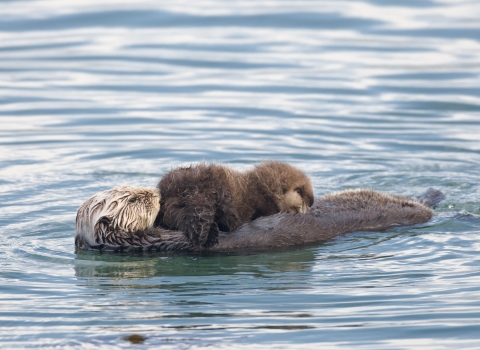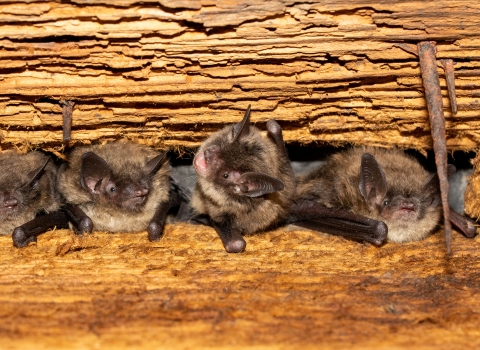Q: Why is the U.S. Fish and Wildlife Service proposing to designate critical habitat for the Florida bonneted bat?
A: The Florida bonneted bat was listed as endangered under the Endangered Species Act (ESA) on October 2, 2013. According to the ESA, critical habitat can be designated, if prudent and determinable, for any species determined to be endangered or threatened, if the Secretary of the Interior deems such areas essential for the conservation of the species. The Secretary of the Interior makes this designation on the basis of the best scientific data available and after taking into consideration the economic impact, the impact on national security, and any other relevant impacts of specifying any particular area as critical habitat. The proposed critical habitat for the bat would help preserve the essential physical and biological features required for survival and recovery of the species.
Q: What does a critical habitat designation mean?
A: Critical habitat, as defined by the ESA, is a specific geographic area that contain features essential to the conservation of a threatened or endangered species that may require special management and protection. Critical habitat may include areas that are not currently occupied by the species but are essential for its conservation.
Q: Why is the Service revising the critical habitat proposal?
A: The Service received substantial public comment and new information following its 2020 proposal, including Tribal comments stemming from consultation with Tribal Nations. Those comments primarily involved requests for exclusion from proposed critical habitat from a variety of individuals, agencies, organizations and Tribes; requests for the designation of additional areas; and comments regarding the physical or biological features and associated methodology used to identify proposed critical habitat units. After analyzing new genetics information, presence and roost data, revisiting the Florida bonneted bat conservation strategy and revising physical and biological features and associated methodology, the Service decided to issue a revised proposal for critical habitat rather than finalize the 2020 proposal. Because we will consider all comments and information we receive during the public comment process and Tribal consultation process, our final determination may differ from this proposal. We will provide responses to comments received during all relevant comment periods in our final rule.
Q: What changes are proposed in the revised critical habitat designation?
A: The revised proposed would designate approximately 1.2 million acres across nine units in 13 counties throughout central and south Florida. The revised proposal reduces critical habitat 21 percent for the Florida bonneted bat from the proposal published in 2020 while still meeting the Florida bonneted bat’s conservation needs.
The proposed revisions to the critical habitat designation include changes to the physical or biological features and the criteria and methodology used to identify those specific areas that constitute critical habitat. Specifically, those include changes to the characteristics of roost trees that are considered as physical or biological features essential to the conservation of the species, and revisions to the draft economic analysis (DEA) which consider the probable incremental economic impacts that may result from this designation of critical habitat.
Q: How do these proposed designations affect private landowners and developers?
A: The ESA allows the Service to identify areas essential to the conservation of endangered or threatened species. Designating critical habitat under the ESA does not affect private landowners unless they implement an action involving federal funds, permits, or activities. Federal agencies must ensure actions they fund, permit or conduct do not destroy or adversely modify designated critical habitats, thereby helping federal agencies and stakeholders to protect and conserve species for future generations. Critical habitat designations do not affect land ownership or establish a refuge, wilderness, reserve, preserve or other conservation area conservation area
A conservation area is a type of national wildlife refuge that consists primarily or entirely of conservation easements on private lands. These conservation easements support private landowner efforts to protect important habitat for fish and wildlife and major migration corridors while helping to keep agricultural lands in production.
Learn more about conservation area , nor allow the government or public to access private lands.
When determining these proposed critical habitat boundaries, the Service made every effort to avoid including large areas of agriculture or developed areas such as lands devoid of native vegetation or covered by buildings, pavement and other structures. The proposed critical habitats fall within the ranges of 42 federally listed species and their existing designated critical habitats, and 89% of the proposed designation overlaps existing conservation lands. This proposal would designate approximately 121,500 acres as critical habitats in areas not already designated as critical habitat or within existing conservation lands.
Q: Can lands within the revised proposed critical habitat units be excluded from the final designation?
A: Yes. If the analysis indicates that the benefits of excluding lands from the final designation outweigh the benefits of designating those lands as critical habitat, then the Secretary may exercise her discretion to exclude the lands from the final designation.
The proposed rule includes lands that meet the definition of critical habitat but for which we are considering possible exclusion from the final critical habitat rule, including tribal lands belonging to the Miccosukee Tribe of Indians of Florida and the Seminole Tribe of Florida, and lands covered by the Coral Reef Commons Habitat Conservation Plan. We will be evaluating all exclusion requests previously received during the 2020 public comment period that still overlap with revised proposed critical habitat. We specifically solicit comments on the inclusion or exclusion of such areas.
Q: Does critical habitat designation affect all activities that occur within the designated area?
A: No. Critical habitat designation does not necessarily restrict activities, but federal agencies must make special efforts to protect the important characteristics of these areas. Only activities that involve a federal permit, license or funding, and are likely to destroy or adversely modify the area of critical habitat will be affected. If this is the case, the Service will work with the agency and, where appropriate, private or other landowners, to amend their project to allow it to proceed without adversely affecting the critical habitat. Thus, most federal projects are likely to go forward, but some will be modified to minimize harm to critical habitat.
Q: Which other threatened or endangered species are found on the lands being proposed for critical habitat for Florida bonneted bats?
A: The lands proposed as critical habitat within this rule overlap with the ranges of 42 federally listed species. Some of Florida’s most well-known species can be found on these lands including Florida panthers, wood storks, eastern indigo snakes, snail kites, Florida scrub jays, Miami tiger beetles, red-cockaded woodpeckers and pine rocklands plants.
Q: Are the lands being proposed for critical habitat designation occupied by Florida bonneted bats?
A: All nine of the proposed units are occupied. View and download the maps and files for the Florida bonneted bat proposed critical habitat units here.
Q: How did the Service determine what areas to designate as critical habitat?
A: Biologists considered physical and biological features the species needs for survival and reproduction. These include:
Space for individual and population growth and for normal behavior.
Cover or shelter.
Food, water, air, light, minerals or other nutritional or physiological requirements.
Sites for breeding, reproduction, and rearing of offspring.
Q: What does the draft economic analysis mean to private landowners in the area?
A: The draft economic analysis (DEA) is comprehensive and considers the economic costs of adding this regulatory designation. The DEA found that the proposed designation would not have a significant economic impact on a substantial number of small business entities and/or private landowners. The total incremental section 7 costs associated with the proposal are estimated to be $70,800 per year. While the proposed critical habitat area is relatively large, the costs are comparatively low due to strong baseline protections that already exist for this listed species, a consultation area map already in use by managing agencies, and the presence of other listed species in the area.
Q: What is the Service doing to help the Florida bonneted bats?
A: Collaborative conservation efforts have focused on: (1) conducting acoustic surveys within the species’ historic range to better understand movements and threats, and to refine delineation of the range; (2) locating natural roosts and identifying factors influencing roost selection; (3) evaluating impacts to individuals living in and around urban areas; (4) using various techniques to accurately and safely monitor existing populations; and (5) increasing public awareness of this endangered species.
Q: What information is the Service seeking through public comment and review?
A: A full description of the information sought through public comment is included in the proposed rule. A summarized description includes:
The reasons why we should or should not designate habitat as “critical habitat”, including factors why designation of critical habitat may not be prudent;
Specific information on the amount and distribution of Florida bonneted bat habitat, including any additional areas occurring within the range of the species that should be included;
Land use designations and current or planned activities in the subject areas and their possible impacts on proposed critical habitat;
Any probable economic, national security, or other relevant impacts of designating any area that may be included in the final designation, and the related benefits of including or excluding specific areas;
Information on the extent to which the description of probable economic impacts in the draft economic analysis is a reasonable estimate of the likely economic impacts and any additional information regarding probable economic impacts that we should consider;
Whether any specific areas we are proposing for critical habitat designation should be considered for exclusion, and whether the benefits of potentially excluding any specific area outweigh the benefits of including that area in critical habitat designations;
Whether we could improve or modify our approach to designating critical habitat in any way to provide for greater public participation and understanding, or to better accommodate public concerns and comments.
Q: How long does the public comment period last? What’s the next step after it ends?
A: The Service seeks comments concerning the amount and distribution of Florida bonneted bats and their habitat, what may constitute physical or biological features essential to the bat’s conservation, suitability of proposed areas for critical habitat, and the draft economic analysis. Additionally, we seek public comment on whether any specific areas we are proposing for critical habitat designation should be considered for exclusion under section 4(b)(2) of the ESA.
At the conclusion of the comment period, the agency will begin the process of reviewing the comments and decide whether to pursue this proposal in the form of a final rule.
The Service will accept comments regarding the revised proposed rule that are received or postmarked on or before January 23, 2023. Comments submitted electronically using the Federal eRulemaking Portal must be received by 11:59 p.m. Eastern Time on the closing date. The agency must receive requests for public hearings, in writing, at the address shown below by January 6, 2023.
You may submit comments on the proposed rule or draft economic analysis by one of the following methods:
(1) Electronically: Go to the Federal eRulemaking Portal: http://www.regulations.gov. In the keyword box, enter Docket Number FWS–R4–ES–2019–0106, which is the docket number for this rulemaking. Then, in the search panel on the left side of the screen, under the document type heading, click on the proposed rules link to locate this document. You may submit a comment by clicking on “Comment Now!”
(2) By hard copy: Submit by U.S. mail or hand-delivery to: Public Comments Processing, Attn: FWS–R4–ES–2019–0106; U.S. Fish and Wildlife Service, MS: BPHC; 5275 Leesburg Pike; Falls Church, VA 22041-3803.
Comments should be sent only by the methods described above. The Service will post all comments on http://www.regulations.gov. This generally means that any personal information provided may be available to the public.




